AVL树
- 1. AVL树的概念
- 2. AVL树的实现
- 2.1 节点的定义
- 2.2 插入
- 2.3 是否是AVL树
- 3. AVL树与红黑树
1. AVL树的概念
AVL树是一棵二叉搜索树,但它的每个节点的左右子树的高度差的绝对值不超过1,且它的子树也是平衡二叉树。左右子树的高度差也叫平衡因子,平衡因子 = 右子树叶的高度 - 左子树的高度。
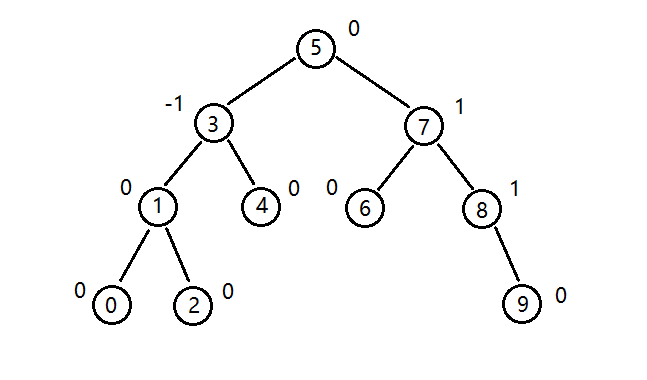
将AVL树与满二叉树对比,看看AVL的效率如何?

2. AVL树的实现
2.1 节点的定义
//节点
template<class K, class V>
struct AVLTreeNode
{AVLTreeNode<K, V>* _left;AVLTreeNode<K, V>* _right;AVLTreeNode<K, V>* _parent;pair<K, V> _kv;int _bf;//平衡因子AVLTreeNode(const pair<K, V> kv):_left(nullptr), _right(nullptr), _parent(nullptr), _kv(kv), _bf(0){}
};
2.2 插入
- AVL树是二叉搜索树,所以首先按照二叉搜索树的规矩插入。插入后再考虑插入节点后,AVL树是否平衡。
- 有个例子
(1)更新后parent的平衡因子如果是1或者-1,说明parent所在子树的高度发生变化,会影响祖先,需要沿着到root的路径往上更新。
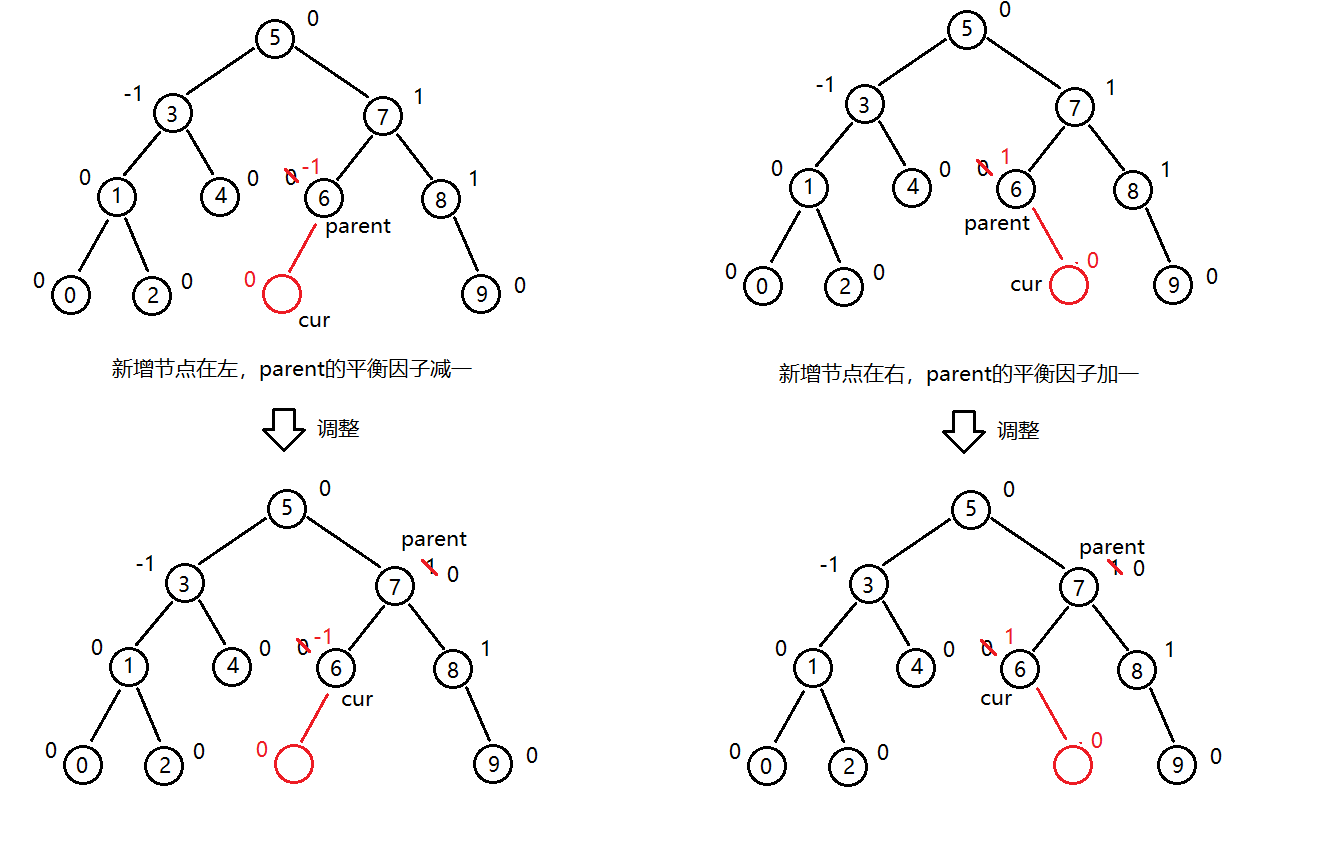
(2)更新后parent的平衡因子如果是0,说明parent所在子树的高度不变,不用继续沿着到root的路径往上更新。

(3)更新后parent的平衡因子如果是2或者-2,说明parent所在子树的高度变化且不平衡,对parent的子树进行旋转,使其平衡。
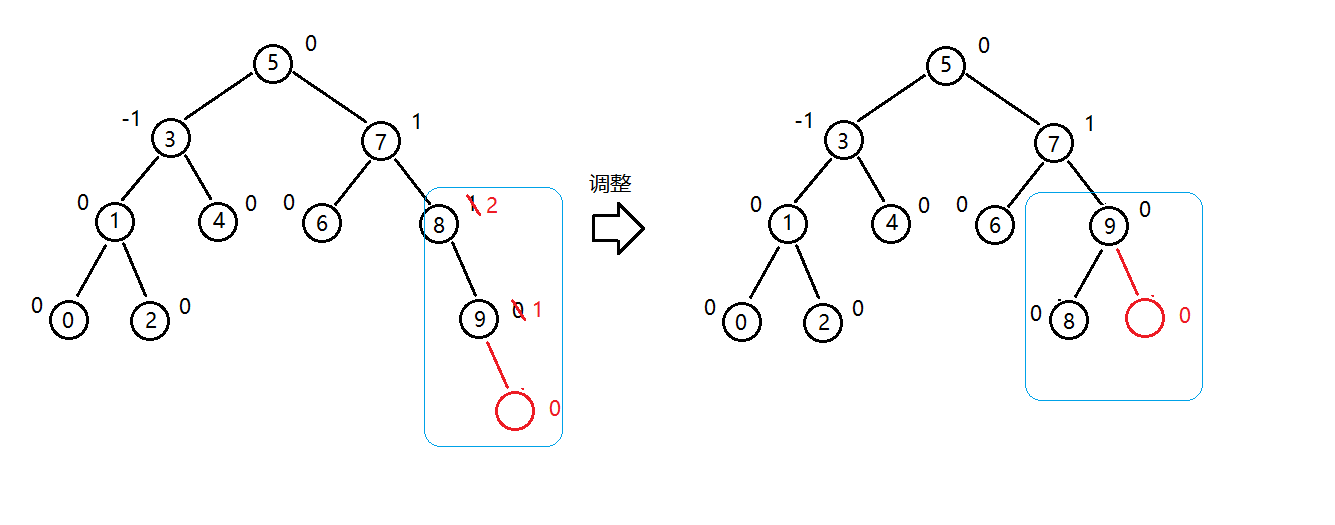
(4)如果parent是头节点,对parent进行旋转后,记得更新根节点。
- 旋转的原理
节点的插入可以分为以下几种情况
(1)左单旋:新节点插入在较高右子树的右侧
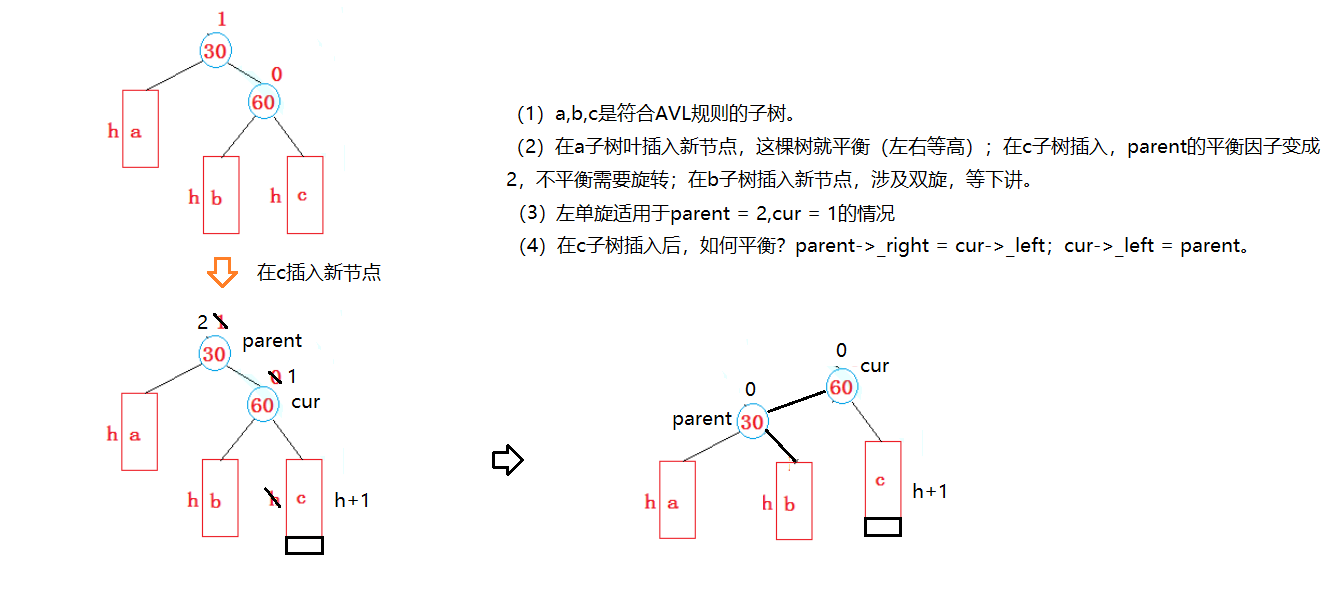
(2)右单旋:新节点插入较高左子树的左侧
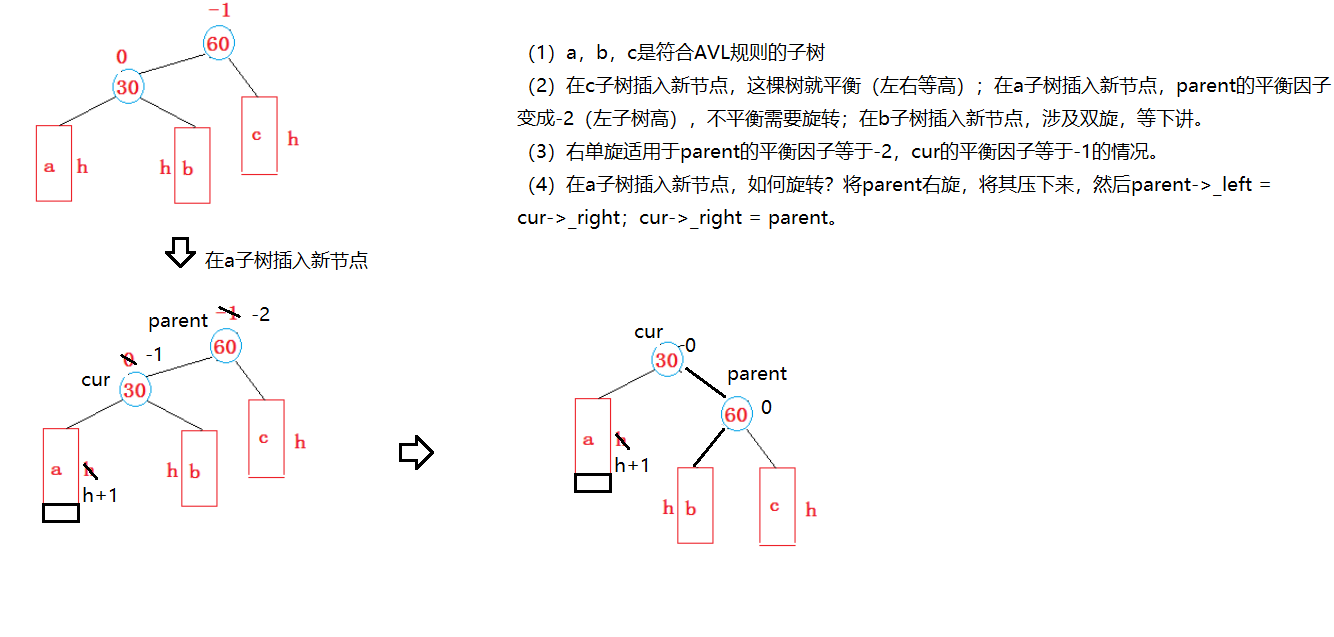
(3)双旋:新节点插入较高右子树的左侧
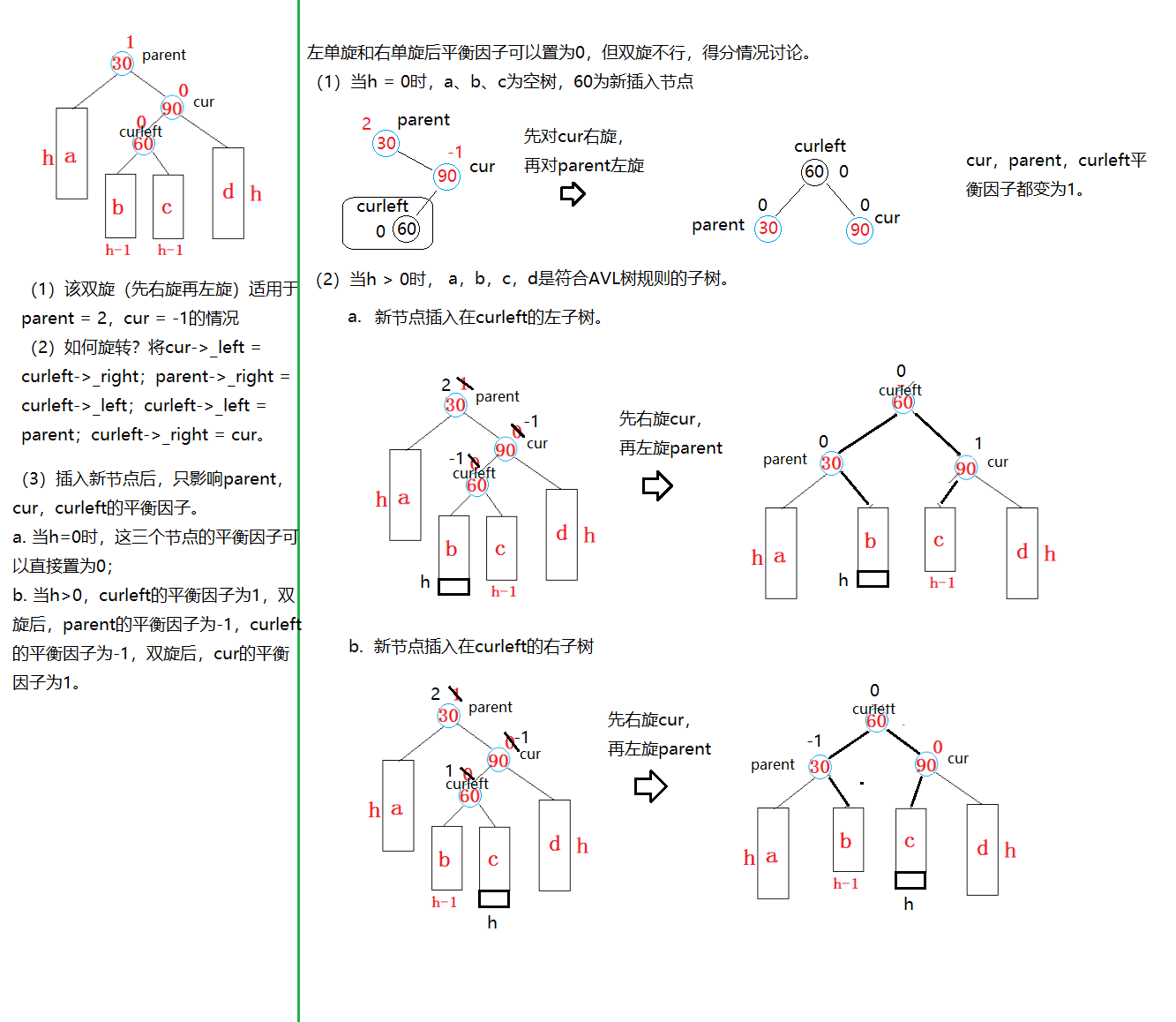
(4)双旋:新节点插入较高左子树的右侧
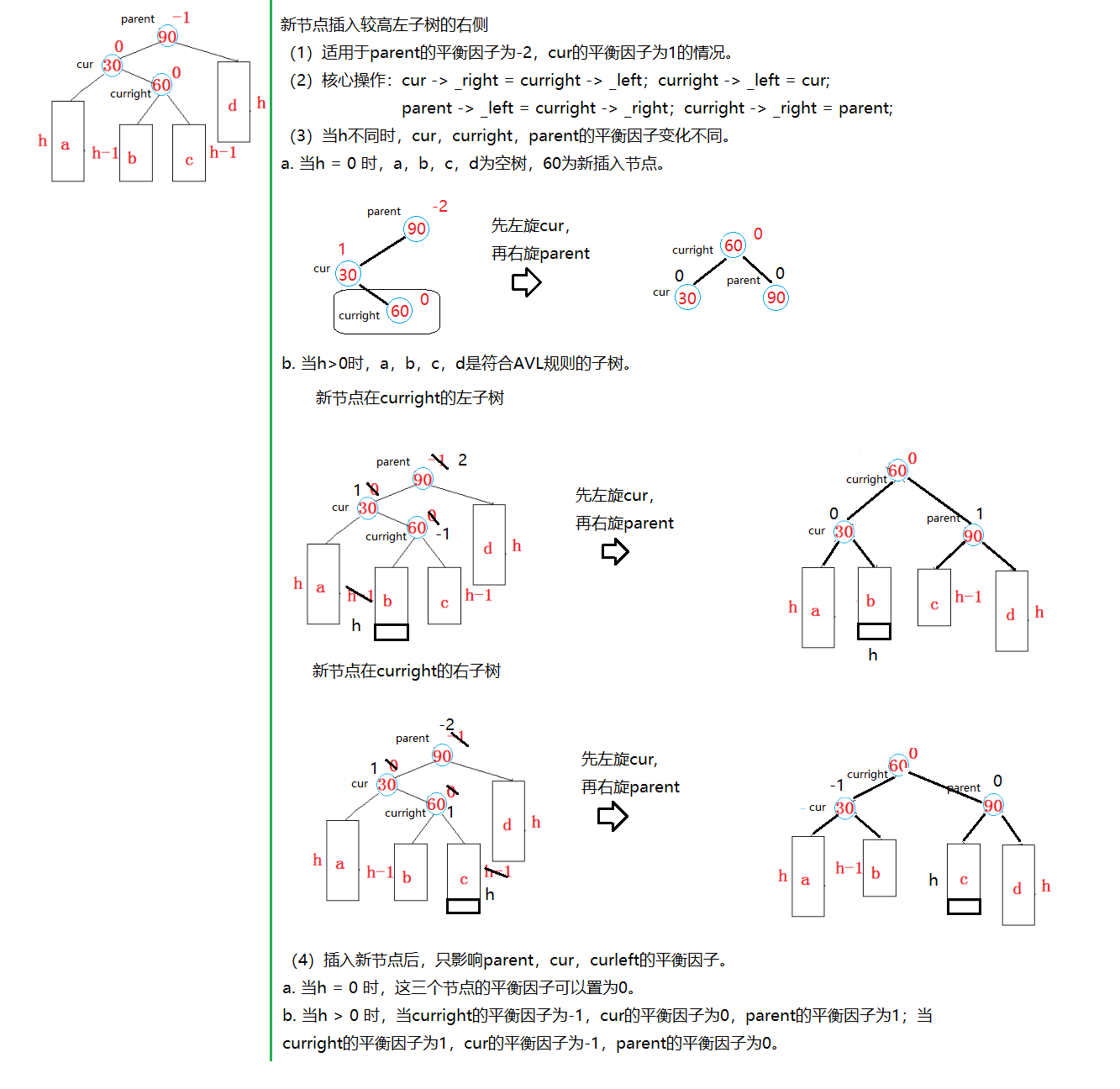
代码
template<class K, class V>
class AVLTree
{
public:typedef AVLTreeNode<K, V> Node;bool insert(const pair<K, V>& kv){if (_root == nullptr){_root = new Node(kv);return true;}Node* cur = _root;Node* parent = cur;while (cur){if (cur->_kv.first < kv.first){parent = cur;cur = cur->_right;}else if (cur->_kv.first > kv.first){parent = cur;cur = cur->_left;}else{return false;}}cur = new Node(kv);if (parent->_kv.first < cur->_kv.first){parent->_right = cur;cur->_parent = parent;}else{parent->_left = cur;cur->_parent = parent;}//更新平衡因子while (parent){if (parent->_left == cur){--parent->_bf;}else{++parent->_bf;}//如果更新完平衡因子为0,说明其左右子树等高,已经平衡if (parent->_bf == 0){break;}//不等高,继续往上更新平衡因子else if (parent->_bf == 1 || parent->_bf == -1){cur = parent;parent = parent->_parent;}//不平衡,分为四种情况else if (parent->_bf == 2 || parent->_bf == -2){//新节点插入较高右子树的右侧,需要将parent左旋if (parent->_bf == 2 && cur->_bf == 1){RotateL(parent);}//新节点插入较高左子树的左侧,需要将parent右旋else if (parent->_bf == -2 && cur->_bf == -1){RotateR(parent);}//新节点插入较高右子树的左侧,需要先将cur右旋,再将parent左旋else if (parent->_bf == 2 && cur->_bf == -1){RotateRL(parent);}//新节点插入较高左子树的右侧,需要先将cur左旋,再将parent右旋else if (parent->_bf == -2 && cur->_bf == 1){RotateLR(parent);}else{assert(false);}break;}else{assert(false);}}return true;}//左旋void RotateL(Node* parent){Node* cur = parent->_right;Node* curleft = cur->_left;parent->_right = curleft;if (curleft){curleft->_parent = parent;}cur->_left = parent;//不要忘记父节点的链接Node* pparent = parent->_parent;parent->_parent = cur;//要考虑parent的parent是否存在if (pparent){if (pparent->_left == parent){pparent->_left = cur;}else{pparent->_right = cur;}cur->_parent = pparent;}else{_root = cur;cur->_parent = nullptr;}//平衡因子置为0parent->_bf = cur->_bf = 0;}//右旋void RotateR(Node* parent){Node* cur = parent->_left;Node* curright = cur->_right;parent->_left = curright;if (curright){curright->_parent = parent;}cur->_right = parent;Node* pparent = parent->_parent;parent->_parent = cur;if (pparent){if (pparent->_left == parent){parent->_left = cur;}else{parent->_right = cur;}cur->_parent = pparent;}else{_root = cur;cur->_parent = nullptr;}parent->_bf = cur->_bf = 0;}//双旋:新节点插入较高右子树的左侧void RotateRL(Node* parent){Node* cur = parent->_right;Node* curleft = cur->_left;//先右旋,再左旋RotateR(cur);RotateL(parent);if (curleft->_bf == 0){parent->_bf = 0;cur->_bf = 0;}else if (curleft->_bf == 1){parent->_bf = -1;cur->_bf = 0;}else if (curleft->_bf == -1){parent->_bf = 0;cur->_bf = 1;}}//双旋:新节点插入较高左子树的右侧void RotateLR(Node* parent){Node* cur = parent->_left;Node* curright = cur->_right;//先左旋再右旋RotateL(cur);RotateR(parent);//更新平衡因子if (curright->_bf == 0){parent->_bf = 0;cur->_bf = 0;}else if (curright->_bf == 1){parent->_bf = 0;cur->_bf = -1;}else if (curright->_bf == -1){parent->_bf = 1;cur->_bf = 0;}}
private:Node* _root = nullptr;
};
2.3 是否是AVL树
如果一棵AVL树不平衡,那么它的左右子树的高度差的绝对值超过2,旋转出现问题。如果要判断一棵树是否是AVL树是否平衡,不能通过平衡因子判断,因为旋转出现问题,那么平衡因子也会出现问题,所以只能通过高度来判断。
代码
// 根据AVL树的概念验证pRoot是否为有效的AVL树bool IsAVLTree(){return IsAVLTree(_root);}bool IsAVLTree(Node* pRoot){//不能依赖平衡因子,容易监守自盗。如果旋转出现问题,平衡因子也会有问题//所以直接通过高度来判断if (pRoot == nullptr){return true;}int leftHeight = Height(pRoot->_left);int rightHeight = Height(pRoot->_right);//abs返回参数的绝对值return abs(leftHeight - rightHeight) < 2&& IsAVLTree(pRoot->_left) && IsAVLTree(pRoot->_right);}int Height(){return Height(_root);}int Height(Node* root){if (root == nullptr){return 0;}int leftHeight = Height(root->_left);int rightHeight = Height(root->_right);return leftHeight > rightHeight ? leftHeight + 1 : rightHeight + 1;}
3. AVL树与红黑树
插入时要维护其绝对平衡,旋转的次数比较多,如果需要一种查询高效且有序的数据结构,而且数据的个数为静态的(即不会改变),可以考虑AVL树,但一个结构经常修改,就不太适合
红黑树不追
求绝对平衡,其只需保证最长路径不超过最短路径的2倍,相对而言,降低了插入和旋转的次数,
所以在经常进行增删的结构中性能比AVL树更优
- AVL树和红黑树都是平衡二叉树。在查询效率方面,AVL树追求绝对平衡,红黑树要求最长路径不超过最短路径的两倍,AVL查询数据效率比红黑树高,但是对于CPU而言,都是属于logN这个量级的。
- AVL树追求控制严格平衡是需要付出代价的,插入和删除已需要进行大量的旋转。红黑树不追求绝对平衡,其只需保证最长路径不超过最短路径的2倍,相对而言,降低了插入和旋转的次数,所以在插入和删除方面红黑树效率更高。
- 综上,红黑书更优,实际运用的多。
)







)
)







联合体和大小端模式)

